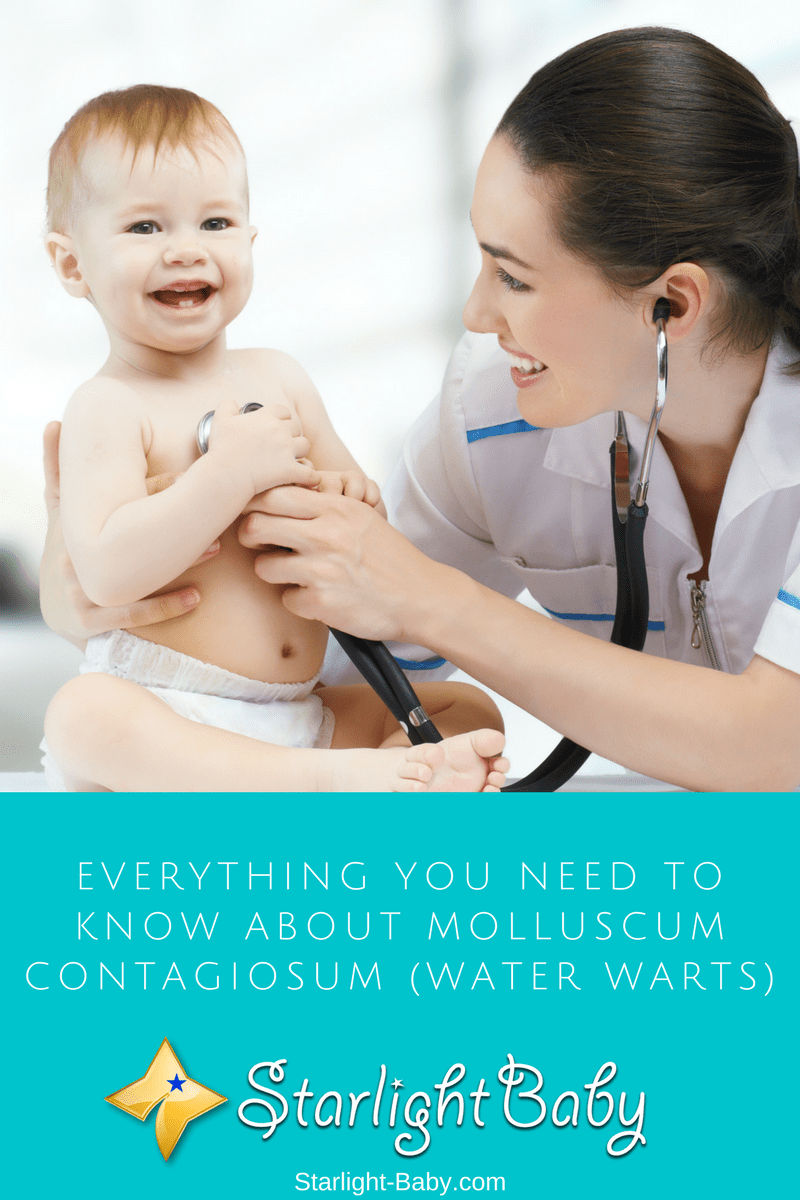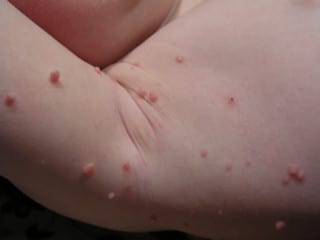 Children have an uncanny ability to pick up all kinds of illnesses and conditions. You’ve probably already lost count of the number of colds your little one has managed to pick up! Frequent illness is something you come to expect as a parent, but some health issues can be a little more worrying than others; particularly if you know very little about them.
Children have an uncanny ability to pick up all kinds of illnesses and conditions. You’ve probably already lost count of the number of colds your little one has managed to pick up! Frequent illness is something you come to expect as a parent, but some health issues can be a little more worrying than others; particularly if you know very little about them.
One common condition which can sound pretty scary, is Molluscum Contagiosum. If your baby or toddler has been diagnosed, or it’s been mentioned to you by a friend or relative that they may have the condition, you’re likely to be understandably concerned. To ease those concerns, here you’ll discover everything you need to know about Molluscum Contagiosum, also known as water warts.
Table of Contents
What Is It?
Molluscum Contagiosum may sound serious, but it’s actually a harmless skin condition. Caused by the Molluscum virus,

a poxvirus, it’s an infectious disease which leads to the development of small growths within the top layers of the skin. It’s spread through direct contact with somebody who already has the condition.
Infants can be affected, but it typically develops in children aged 1-5. If your infant does develop the condition, the symptoms will usually be worse if they already suffer from Eczema.
The condition is considered highly contagious, so if your child does develop it, care should be taken to avoid infecting other children. This could mean keeping them away from day care until it can be controlled.
What Symptoms Should You Look Out For?
The main symptom associated with Molluscum Contagiosum, is small, raised skin-colored lesions. These lesions tend to have a small depression or dot in the center. They’ll either be found in a straight line, or in tiny clusters. They can occur anywhere on the boy, but in children they’re most commonly found on the neck, thighs, armpits, face and eyelids.
The number of lesions will determine how severe the condition is. If there’s less than 10 spots present, it’s considered mild. If there’s between 10 and 50 spots, it’s a sign of a moderate infection, while over 50 lesions points to a more severe infection.
The lesions don’t typically cause any pain, though they can become quite itchy. This can cause them to turn red and become inflamed.
Does It Need To Be Treated?
In most cases, Molluscum Contagiosum will clear up by itself within six to twelve months. However, you should have the condition diagnosed by a doctor to ensure it is the cause of the lesions. Depending upon the severity of the disease, the doctor may recommend treatment.
There’s a few treatment options available for moderate to severe cases including:
- Chemical application
- Cryosurgery
- Creams
With chemical applications, they can either be alkali or strong acid based chemicals which are applied to the affected areas. Cryosurgery involves freezing off the lesions, but the doctor may instead recommend other removal methods such as burning, laser or scraping them off. Finally, prescription creams may be used. However, in the majority of cases the disease does tend to clear up on its own without treatment.
An interesting fact about the treatment of the condition, is that all simple treatments used are designed to irritate the spots. This actively encourages the body to fight the infection and is why you’ll often see the spots become inflamed and red once treatment begins. It’s nothing to be worried about, it’s just showing the treatment is working.
One treatment which may be recommended is something commonly referred to as “Beetlejuice treatment”. However, while it can prove effective, many parents have warned against it due to how painful it leaves the area. It’s also known to leave behind scarring.
There’s also advice online which states to apply essential oils onto the affected areas. However, when treating babies and toddlers, many essential oils can be toxic so it’s absolutely vital you don’t try out any essential oil treatments without first consulting a doctor or pediatrician.
Spread Prevention Tips
The only real threat Molluscum Contagiosum presents is the risk of spreading. Therefore, the most important thing you can do is ensure your little one doesn’t spread it both to other children, and to other parts of the body.
The U.S. Centers for Disease Control, recommend covering affected areas with bandages if they aren’t covered by clothing. This will both stop your child from scratching the area, as well as prevent it being spread to others. They also recommend taking these bandages off overnight, then putting clean ones on in the morning.
If you plan on taking your child swimming, it’s also recommended you use tight, waterproof bandages. Any towels used should also not be shared with others and bandages should be disposed of once you get home.
One thing you may not know is that the Molluscum Contagiosum virus can actually live in water. So, you’ll want to be wary of bathing your toddler. Where possible, use a shower instead of bath. As the virus can spread through towels, it’s also a good idea to use a fresh towel to dry your child, and dry the affected areas last.
Conclusion
Overall, Molluscum Contagiosum is usually a harmless disease, but it can be extremely contagious. It’s also worth keeping in mind that although it will usually clear up within six months to 12 months, it’s possible children can have the small lesions for a few years. As long as the lesions are present, they will need to be covered to prevent the risk of spreading it to others.
Disclaimer:
This article is for informational purposes only and should not be considered medical advice. Always consult with a doctor or licensed medical professional before making any medical decisions.

I admit I had never heard of Molluscum Contagiosum, however, I have seen some kids showing this condition. As a parent of 8 months old baby, I am reading everything related to babies. Thankfully, my baby is now showing any of the symptoms of Molluscum Contagiosum, however, if he ever shows the symptoms, I now know what to do.
Yes, as a parent, it is always best to be ready for anything. It’s difficult to be in the dark about illnesses or diseases that could affect kids so having an idea about them would help ease some of the worries and fears 🙂
It’s really helpful this information for all the mothers. It’s reminding all the mothers to be careful and to inform anout this kind of disease and also helping me yo spread this infornatiob for my sister who’s having now a baby.
Thank you very much for helping us spread this information, Camille. We truly appreciate it. Please feel free to read our other articles which you can find here: https://kinacle.com/category/blog
Happy reading 🙂
Molluscum Contagiosum? To be honest I have heard about this before. Maybe it has another name it’s been called here but from seeing the picture of the skin disease and reading that it’s contagious, I wouldn’t consider it to be a harmless disease. In my opinion, once this appears, it’s indeed paramount to have this treated with waiting for it to heal on its own because before then, all the kids in one’s house would already be infected.
Yes, you’re right. Despite it’s being harmless, it needs to be treated because it is contagious. And they’re not pleasant to look at.
It’s really shocking to learn about such contagious disease in children and the worrying part of the it is that Molluscum Contagiosum can’t be cured by any medical drug, but allowed to dry on its own within the interval of 6-12 months. The only thing I have to say is the need for parents to take good care of their kids to ensure they don’t get this disease from other kids around.
True – parents should always be careful when it comes to their children’s health. Although sometimes, no matter how careful we are with our kids, they still suffer from certain diseases that they may have caught from kids in school. For this, it should be the parents’ responsibility to not send their children to school if they are suffering from a highly contagious disease (not necessarily Molluscum Contagiosum). An example is chicken pox which could spread to those who are not yet immune to the disease.
When you should stop covering your molluscum ? I have 8 bumps 6 big and 2 flat bumps, i dont to do to the flat one because they are in my penis shaft 😭 I am using tea tree oil combine with betadine (povidone-iodine) the larger one get dried and scab off but they have still a white in the middle, does it show that molluscum doesnt go away ? 😭
Hello! Your molluscum may get irritated if you cover it.
As for your question on molluscum going away, experts say it ” typically disappears in about 2 to 3 months. However, new growths generally appear as old ones are going away. So it usually takes 6 to 18 months (and can take as long as 4 years) for molluscum contagiosum to go away completely.” Here’s more on this if you want to know more: https://kidshealth.org/en/teens/molluscum-contagiosum.html